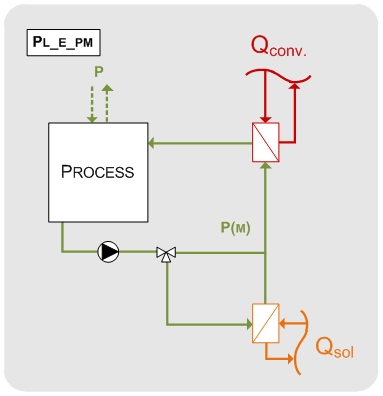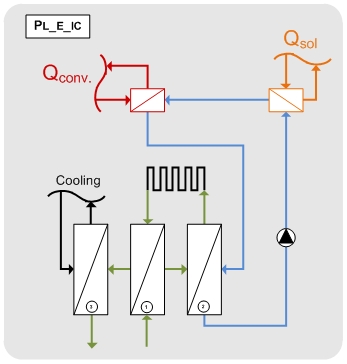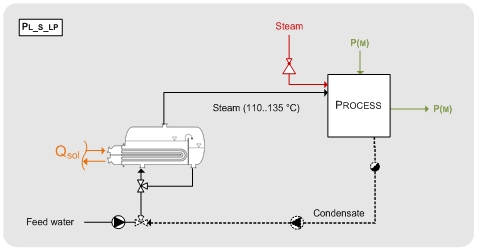Back to EFFICIENCY FINDER
| Different process technologies exist within industry, which lead to several possibilities for the integration of solar heat. Based on the general classification of industrial heat consumers pasteurization and sterilization processes are assigned either to the category “(pre)heating of fluid streams” or “heating and maintaining temperature of baths, machineries or tanks”. By consideration of the conventional heat supply, different integration concepts are possible.
|

|
PL_E_PM - external HEX for heating of product or process medium
This integration concept is basically the easiest since an additional solar driven heat exchanger is installed in serial to the conventional heat exchanger to heat a product or process medium (e.g. water, lye, fruit juice, etc.). It can be applied to all three categories of heat consumers “(pre)heating of fluid streams”, “heating and maintaining temperature of baths, machineries or tanks” and “thermal separation processes”. The serial integration of a solar driven heat exchanger can be realized in a way that only part of the entire product or process medium stream is heated up and hence heat exchanger surface, pump and pipe dimensions can be kept small.
|

|
PL_E_IC - external HEX for heating of intermediate hot water circuit
Within the food and beverage sector intermediate hot water circuits can be used to heat sensitive products. Therefore, the conventional heat transfer medium is used to heat this hot water circuit to a temperature slightly above the required set temperature of the product (e.g. pasteurization of milk). In these cases integration concept PL_E_IC can be applied. This concept equals more or less PL_E_PM. Due to the fact that solar heat is used to heat water, the integration is usually easier in case of the required heat exchanger or safety installations compared to the direct solar heating of products. If a process is directly heated by a conventional hot water circuit, the integration concepts PL_E_IC and SL_L_RF can be combined. Therefore, the return is preheated with solar energy directly behind the process since the average temperature of the central return line is usually higher.
|

|
PL_E_HB - external HEX for heating of bath, machinery, or tank
This integration concept is used to heat baths, machineries, or tanks via an additional external heat exchanger. Therefore, the product or process medium is drawn from the bath, machinery, or tank, heated by solar energy and fed back. It’s crucial for this integration concept to identify a suitable position or point in time within the process where the temperature of the product or process medium is relatively low. Else this concept would lead to a parallel integration of solar heat to the conventional heat supply. If the product or process medium must be kept in a very narrow temperature range (due to operational issues), the resulting temperature difference for solar heating might be very small.
|

|
PL_I- Process level with internal heat exchanger
The integration of an additional heat exchanger surface within baths, machineries, or tanks is used for the category “heating and maintaining temperature of baths, machineries, or tanks”. Usually, the additional solar driven internal heating surface is installed in parallel to the conventional heat source. For this concept it is important to consider the available space in the process equipment since it is usually limited due to the treated product (e.g. metal parts) or components (e.g. stirrers, strainers, etc.).
|

|
PL_S_LP solar steam generation at low pressure
For solar steam supply with reduced pressure of 1.5 - 3 bar (according to 110 - 135 °C) a kettle reboiler is required that is supplied with solar heat. Feed water or condensate is fed into the reboiler, evaporated and used to heat the process. Therefore, the conventional steam demand for injection heating is reduced. Based on the required installations this integration concept is similar to SL_S_PI on supply level. The only difference is the reduced temperature level compared to conventional steam systems in Industry. Therefore, this integration concept can also be applied under moderate climatic conditions.
|
| Source: Schmitt, B., 2014. Integration of solar heating plants for supply of process heat in industrial companies (in German language), Dissertation University of Kassel, Shaker Verlag, Aachen, Germany.
|
- help topics
Back to EFFICIENCY FINDER